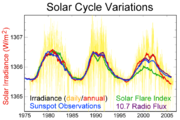
Solar maximum
Encyclopedia

Solar cycle
The solar cycle, or the solar magnetic activity cycle, is a periodic change in the amount of irradiation from the Sun that is experienced on Earth. It has a period of about 11 years, and is one component of solar variation, the other being aperiodic fluctuations. Solar variation causes changes in...
of the sun
Sun
The Sun is the star at the center of the Solar System. It is almost perfectly spherical and consists of hot plasma interwoven with magnetic fields...
. During solar maximum, sunspot
Sunspot
Sunspots are temporary phenomena on the photosphere of the Sun that appear visibly as dark spots compared to surrounding regions. They are caused by intense magnetic activity, which inhibits convection by an effect comparable to the eddy current brake, forming areas of reduced surface temperature....
s appear.
A solar maximum is the period when the sun's magnetic field lines are the most distorted due to the magnetic field on the solar equator rotating at a slightly faster pace than at the solar poles. The solar cycle
Solar cycle
The solar cycle, or the solar magnetic activity cycle, is a periodic change in the amount of irradiation from the Sun that is experienced on Earth. It has a period of about 11 years, and is one component of solar variation, the other being aperiodic fluctuations. Solar variation causes changes in...
takes an average of about 12 years to go from one solar maximum to the next, with an observed variation in duration of 9 to 14 years for any given solar cycle.
For more detailed explanation of solar cycles, see Solar variation
Solar variation
Solar variation is the change in the amount of radiation emitted by the Sun and in its spectral distribution over years to millennia. These variations have periodic components, the main one being the approximately 11-year solar cycle . The changes also have aperiodic fluctuations...
.
Historic maxima

The unreliability of solar maxima is demonstrated in that NASA
NASA
The National Aeronautics and Space Administration is the agency of the United States government that is responsible for the nation's civilian space program and for aeronautics and aerospace research...
had previously predicted the solar maximum for 2010/2011 and possibly to occur as late as 2012. Previously, on March 10, 2006, NASA researchers had announced that the next solar maximum would be the strongest since the historic maximum in 1859
Solar storm of 1859
The solar storm of 1859, also known as the Solar Superstorm, or the Carrington Event, which occurred during solar cycle 10, was the most powerful solar storm in recorded history, and the largest flare, observed by Richard Christopher Carrington, became known as the Carrington Super...
in which the northern lights
Aurora (astronomy)
An aurora is a natural light display in the sky particularly in the high latitude regions, caused by the collision of energetic charged particles with atoms in the high altitude atmosphere...
could be seen as far south as Rome
Rome
Rome is the capital of Italy and the country's largest and most populated city and comune, with over 2.7 million residents in . The city is located in the central-western portion of the Italian Peninsula, on the Tiber River within the Lazio region of Italy.Rome's history spans two and a half...
, approximately 42° north of the equator, by 2011, this appeared to be incorrect.
Film
There is an IMAXIMAX
IMAX is a motion picture film format and a set of proprietary cinema projection standards created by the Canadian company IMAX Corporation. IMAX has the capacity to record and display images of far greater size and resolution than conventional film systems...
documentary
Documentary film
Documentary films constitute a broad category of nonfictional motion pictures intended to document some aspect of reality, primarily for the purposes of instruction or maintaining a historical record...
about solar maxima called Solarmax.
See also
- Solar cycle 24Solar Cycle 24Solar Cycle 24 is the 24th solar cycle since 1755, when recording of solar sunspot activity began. It is the current solar cycle, and began on . The cycle continues to fall below predictions and is currently exhibiting 50% lower sunspot activity than predicted in May 2009.-Predictions:It is...
- Solar minimumSolar minimumSolar minimum is the period of least solar activity in the solar cycle of the sun. During this time, sunspot and solar flare activity diminishes, and often does not occur for days at a time...
- List of solar cycles – table of solar cycles
- Solar Maximum MissionSolar Maximum MissionThe Solar Maximum Mission satellite was designed to investigate solar phenomenon, particularly solar flares. It was launched on February 14, 1980....

